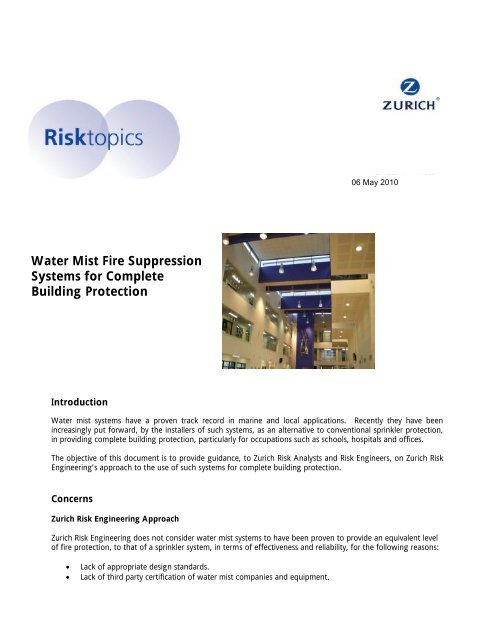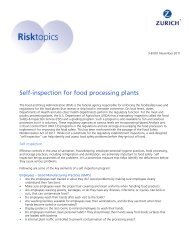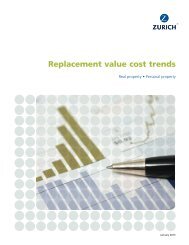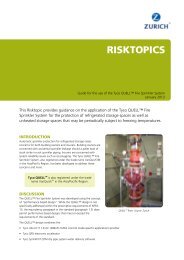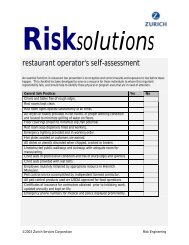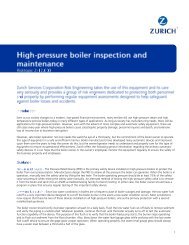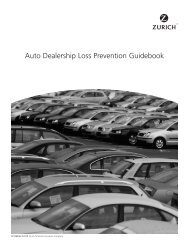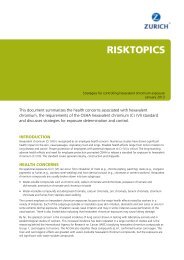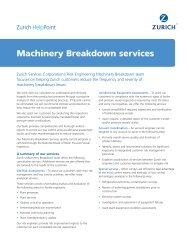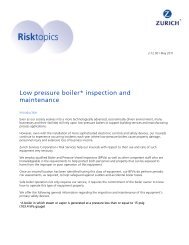Water Mist Fire Suppression Systems for ... - Risk Engineering
Water Mist Fire Suppression Systems for ... - Risk Engineering
Water Mist Fire Suppression Systems for ... - Risk Engineering
- No tags were found...
You also want an ePaper? Increase the reach of your titles
YUMPU automatically turns print PDFs into web optimized ePapers that Google loves.
06 May 2010<strong>Water</strong> <strong>Mist</strong> <strong>Fire</strong> <strong>Suppression</strong><strong>Systems</strong> <strong>for</strong> CompleteBuilding ProtectionIntroduction<strong>Water</strong> mist systems have a proven track record in marine and local applications. Recently they have beenincreasingly put <strong>for</strong>ward, by the installers of such systems, as an alternative to conventional sprinkler protection,in providing complete building protection, particularly <strong>for</strong> occupations such as schools, hospitals and offices.The objective of this document is to provide guidance, to Zurich <strong>Risk</strong> Analysts and <strong>Risk</strong> Engineers, on Zurich <strong>Risk</strong><strong>Engineering</strong>’s approach to the use of such systems <strong>for</strong> complete building protection.ConcernsZurich <strong>Risk</strong> <strong>Engineering</strong> ApproachZurich <strong>Risk</strong> <strong>Engineering</strong> does not consider water mist systems to have been proven to provide an equivalent levelof fire protection, to that of a sprinkler system, in terms of effectiveness and reliability, <strong>for</strong> the following reasons:• Lack of appropriate design standards.• Lack of third party certification of water mist companies and equipment.
• Limited fire test data and relevance of test compared to premises to be protected.• Ability to protect all areas of premises, e.g. stock rooms, gym stores, external canopies, kitchens andplant rooms, etc. not proven.• Ability to provide protection <strong>for</strong> different methods of construction, or products used in construction, notproven.• Ability to deal with design features of premises, which may affect per<strong>for</strong>mance of systems, e.g. Atriums,areas with ceilings over 5m high, open cell ceilings and plenums etc. not proven.• Ability to provide the protection against incidents involving deliberate ignition, where doors andwindows to protected areas, may well be open, following <strong>for</strong>cible entry.Design StandardsSprinkler installations are designed and installed by supervised companies to BS EN 12845. In addition to this,other fire protection standards are used such as Factory Mutual (FM) and National <strong>Fire</strong> Protection Association(NFPA). There is currently no equivalent British or European Standard to cover the design and installation of watermist systems, however, there are the standards described below.BS EN 12845: 2009The design of sprinkler installations <strong>for</strong> buildings, such as modern schools, offices and hospitals, is particularlychallenging due to the diversity of areas to be protected, the high number of other services to coordinate withand the nature, and <strong>for</strong>m, of the structures themselves. This inevitably leads to extensive <strong>Risk</strong> ImprovementAction points being created within our reports to cover the spacing and location of sprinkler heads, accuracy ofhydraulic calculations and areas of protection. All these items are, however, prescriptively set out within BS EN12845, providing us with a base level of acceptability.For reference purposes the following table sets out Ordinary Hazard Classification design criteria <strong>for</strong> sprinklersystems as stated in BS EN 12845:2009Occupancy Design Area of ExamplesClassification Density OperationOH1 5 mm/min 72m2 Class Rooms, Hospital WardsOH2 5 mm/min 144m2 Offices, Laboratories, Metal Workshops,Car Parks.OH3 5 mm/min 216m2 Plant Rooms, Storage Rooms, Retail Areas.OH4 5 mm/min 360m2 Theatres, Exhibition SpacesNFPA 750Tender specifications received <strong>for</strong> water mist systems often state 'in accordance with NFPA 750'. This is not a fully<strong>for</strong>med design document (such as BS EN12845 <strong>for</strong> sprinklers) and is not considered an extensive standard, but isviewed as a guidance document. It defines water mist, based on droplet size, as low pressure and high pressureand it refers to local application and area protection systems.It states that all systems and applications are required to have proven capability by means of risk specific, realisticfire per<strong>for</strong>mance tests, which must be carried out to suit the application and risk features. These tests must beverified by recognised approved test laboratories and all equipment must also be listed, as approved <strong>for</strong> thatapplication, and listed with UL FM, Vds, LPCB or similar approvals listing organisation.NFPA 750 states that systems with proven extinguishing capability, usually local applications such as industrialfryers, are required to have twice the proven water duration. Control systems, usually area protection systems,must have at least 30 minutes of water supply.
Many installers have not had their equipment, such as nozzles, control valves and pumping equipment, tested orevaluated by an approvals listing organisation <strong>for</strong> corrosion, blockage and reliable per<strong>for</strong>mance, nor have theycompleted suitable tests <strong>for</strong> each application or design feature, as described in this document.International Maritime (IMO) Standard A800The International Maritime Organisation (IMO) Standard A800 is intended <strong>for</strong> water based vessels. It is notadequate to simply transfer this standard to land based applications, as the construction, compartment sizes andfire loadings, of marine vessels, bear no resemblance to those generally found within buildings.Draft British Standard <strong>for</strong> <strong>Water</strong> <strong>Mist</strong> <strong>Systems</strong>There is currently a draft British Standard <strong>for</strong> the design and installation of water mist systems. It has to berecognised that this is a very generic document, placing complete reliance on non-certified or regulatedcontractors. They will have to produce and adhere to their own design and per<strong>for</strong>mance specifications, and theresponsibility will be placed on the contractor to ensure the relevant fire testing is carried out, <strong>for</strong> the applicationin which the water mist system is to be installed.Recently received specifications, <strong>for</strong> water mist installations, have made reference to the use of a combination ofthe above named standards, with additional references <strong>for</strong> compliance with aspects of BS EN 12845 and BS9251:Sprinkler Installations <strong>for</strong> Residential & Domestic Occupancies. Such systems have been described as ‘alternativesprinkler installations’. It will not be possible to control, or verify, the use of this type of hybrid system, as thedifferent standards quoted have conflicting requirements <strong>for</strong> various aspects.As water mist systems are per<strong>for</strong>mance based, and each installer produces their own design guide, this will makeverification of these systems extremely difficult and time consuming, as specialist knowledge, of each contractor’sdesign guides, systems and components, will be needed. Without the presence of a single standard to cover thedesign, installation and commissioning of these systems, this will leave open to question the adequacy of the levelof protection provided.Third Party CertificationTo ensure that installed sprinkler systems meet the prescriptive standards, set out in BS EN 12845, sprinklerinstallation contractors are required to be registered with an approved third party certification body. Within theUnited Kingdom, the leading organisation, in this regard, is the LPCB (Loss Prevention Certification Board). Thereis a secondary scheme to which contractors may be registered, namely FIRAS.There is currently no third party certification scheme available within the United Kingdom to control and supervisethe installation of water mist systems or the installing companies and staff. This leaves the industry unregulatedand provides no peace of mind, <strong>for</strong> end users and stakeholders alike, as to the quality of the installation or theequipment used.<strong>Fire</strong> TestingThe design of sprinkler installations is based on historic fire loss data and extensive full scale fire testing of theareas and fire loadings to be protected. This testing is carried out by recognised bodies such as the BuildingResearch Establishment (BRE), Factory Mutual (FM), National <strong>Fire</strong> Protection Association (NFPA), and UnderwritersLaboratories (UL).To date, no comparable data is available <strong>for</strong> water mist systems and the latest draft British Standard calls <strong>for</strong> firetesting to be carried out <strong>for</strong> all new applications. Other than the water mist testing, undertaken by the IMO <strong>for</strong>marine based applications, some additional land based application testing has been carried out by water mist
companies, however, the test criteria used bares no resemblance to the fire loadings <strong>for</strong> the purposes of thisdocument and is inadequate, when compared with the expected practice throughout the fire protection industry.<strong>Fire</strong> Engineered Building DesignIn addition to the obvious benefits of installing sprinkler protection to protect a premises Approved Document B:<strong>Fire</strong> Safety Volume 2 - Buildings other than Dwelling Houses and BB100: <strong>Fire</strong> Safety in Schools offer otherattractive benefits, which will appeal to architects, local authorities, project sponsors and end users.Based on the provision of a fully compliant sprinkler system, it is acceptable to look to reduce other fireprotection measures <strong>for</strong> both property protection and life safety elements. These include the level of automaticfire detection to be provided and fire resistance of compartments, e.g. from 60 minutes to 30 minutes fireresistance. These reductions can offer significant financial savings which can be offset against the cost of aconventional fire sprinkler system. In addition, unparalleled design freedoms can be achieved, in the <strong>for</strong>m oflarger compartment sizes, e.g. from 800m² to 2000m², extended travel distances and the potential reduction inthe number of fire escape staircases.A significant number of other trade-offs, or design freedoms, exist and the provision of sprinklers can bringunparalleled flexibility in design.The use of water mist systems will not permit the same deviations from the building regulations, as af<strong>for</strong>ded tothe use of sprinkler systems. The main reason <strong>for</strong> this, is that currently, there is no applicable proven designstandard <strong>for</strong> water mist systems and, as such, the same level of reliability cannot be assumed.Modern Methods of ConstructionThe desire to create an innovative and sustainable built environment is constantly increasing. The introduction ofsuch schemes as the BRE Environmental Assessment Methods (BREEAM) has charged architects, engineers,designers and end users, with ensuring that their new buildings have a low environmental impact, reducedrunning costs, and demonstrate progress towards corporate and organisational environmental objectives. Due tothis requirement, most new projects are using modern methods of construction to achieve a “very good” or“excellent” rating. This has had a huge effect on the materials used in construction, the type of services providedand as such an effect on the way a building will behave under fire conditions.An example of this is the use of treated or untreatedtimber, which is particularly prevalent in new buildprojects, as it is seen as a sustainable material and hasbeen ethically sourced. This not only includes the use oftimber cladding on the external face of a building as afinish, but also the structural frame and internal walls.
Another example is the insulation of buildings taking many different <strong>for</strong>ms and using alternative materials toachieve high standards of thermal per<strong>for</strong>mance. Whilst most of these materials are tested and found to have fireresisting qualities, some being used do not, such as recycled newspaper. In such buildings, the active firesuppression system plays a large role in ensuring that a fire will not lead to a total loss. Sprinkler installations havebeen extensively tested and installed throughout a wide range of differing building types.The testing referred to within the IMO standards <strong>for</strong> water mist systems is based on the construction of a ship,where each individual room is a relatively small steel fire resistant compartment. The only additional fire loadingsin this instance would be the furnishings within the room and items brought into the space by the occupant. Inmost buildings, regardless of the hazard classification, the fire loading will be significantly higher.Hazard ClassificationSchoolsOriginally, sprinkler installations <strong>for</strong> schools were deemed to be Light Hazard within BS 5306 Part 2:1990. It soonbecame apparent that the fire loadings within these premises, coupled with the larger compartment sizes beingcreated, meant that this classification needed to be increased. Following the introduction of Technical Bulletin 34– Sprinkler Protection of Schools in July 2003, the classification was increased to a minimum of Ordinary HazardGroup 1, with the condition that this may need to be increased further should there be higher fire loadingspresent. To date, this classification has remained the same and was carried <strong>for</strong>ward into the new EuropeanStandard BS EN 12845 Technical Bulletin 221.What has not remained the same, however, are the buildings being protected by these systems. With the adventof the Building Schools <strong>for</strong> the Future project and the need to provide innovative and inspiring educationalfacilities <strong>for</strong> today’s children, these buildings are now taking an appearance more commonly associated withshopping malls and city centre office blocks. As insurers of these premises, we need to take a balanced view ofthe level of fire protection systems, which will be acceptable to ourselves, not only to protect our own bottomline, but also to safeguard the assets and investments of our customers.Generally sprinkler installations within schools are designed as Ordinary Hazard Group 1, although the presenceof areas, such as theatre stages, stock rooms, car parks, plant rooms, etc., would ideally require a higherclassification, typically Ordinary Hazard Group 3. From the outset, one of the main stumbling blocks of achievingsprinkler protection of schools was the size of the water supplies, due to the requirement <strong>for</strong> 60 minutes ofstored water. This problem was addressed within the Technical Bulletin which permitted 30 minutes of storedwater <strong>for</strong> Ordinary Hazard Group 1 occupancies, only with the provision of a <strong>Fire</strong> Brigade inlet connection. Nosuch reduction, in stored water capacity, is currently offered <strong>for</strong> higher classifications.Due to the safety margins, built into sprinkler installations, we can take com<strong>for</strong>t in the knowledge that shouldone of these systems be called into action, the additional flows and pressures achieved from the operation of thefirst sprinklers, will inevitably control a fire within its area of origin and in many cases achieve extinguishment.As water mist systems are entirely per<strong>for</strong>mance based, with no level of over-engineering, we cannot have thesame faith.
Offices, Hospitals, etc.These premises include some of the same features mentioned in the above section relating to school premises,such as plant rooms, stock rooms, etc. There are some features unique to these premises that also create bigchallenges <strong>for</strong> sprinkler installations and at present are well beyond the capability of water mist systems. Thesewill include areas such as multi floor atriums, lift motor rooms and voids crammed with services such as ducting,cable trays and other services.Hospitals have other issues, in addition to those mentioned, such as on-site laundries and stores, largecommercial kitchens and even some retail outlets, all beyond proven capability of water mist systems <strong>for</strong> landbased applications.Areas to be ProtectedSprinkler installations are capable of effectively protecting all areas of a building. There are several areas,however, in which the application of water mist would simply not be appropriate. The following list of features,whilst not being exhaustive, would typically be found in educational, retail, commercial and local authoritybuildings:External canopiesDue to the smaller droplets produced by water mist systems, this would make protection of these areas notpossible due to the effects of the weather. This would leave buildings vulnerable to exposure hazards fromexternally set fires, which would not be uncommon below such areas.Halls/AtriaCurrently water mist systems are limited in their capabilities to protectareas greater in height than 5 metres. Virtually every new school andoffice building will incorporate areas in excess of this height, be it aGames or Assembly Hall, Central Atrium or a ‘street’. Only water mistdeluge type applications are suggested <strong>for</strong> ceilings, higher than 5metres, but are not proven by suitable fire tests.Ceiling VoidsCurrently water mist systems are limited in their capabilities to protect voids with a depth in excess of 800mm,with a suggestion to treat larger voids as rooms, but ignoring likely obstructions and issues found in voids such asducts, cable trays and <strong>for</strong>ced air plenums.For sprinkler installations to be deemed compliant, voids in excess of 800mm require to be protected.
Naturally Ventilated BuildingsBuildings with natural ventilation systems are becoming more popular, as architects and local authorities seek toprovide environmentally friendly buildings, with lower running costs and reduced carbon footprint. These systemsincorporate facilities <strong>for</strong> the automatic opening of windows to cool the building overnight. Such openings in thebuilding fabric will present the same problem to water mist systems as that below external canopies in that thesmaller water droplets will be affected by the air movement created.Air PlenumsThese are typically an unoccupied space, such as a ceiling void, in which air is moved or circulated throughout theconfines of the space, at above or below atmospheric pressure <strong>for</strong> heating, ventilating or air conditioningpurposes. It is now a requirement that these areas are sprinkler protected. The size of the water droplets from thesprinkler spray should not be affected by this.The behaviour of a water mist system is not known at this time, as no specific research has been carried out,however the fine droplets produced by the water mist system are likely to be affected by the air movement andatmospheric pressure within the plenum and, as such, render the system inadequate under such conditions.StorageStorage areas are to be found in all buildings, regardless of theoccupancy, an example of this being a Sports Store, within aschool. Typically these areas would include the storage of gymmats and other plastic equipment, such as bats and balls. Theseitems are generally produced using materials like expandedplastics, expanded foam plastics and unexpanded plastics.Within BSEN12845: 2009 this situation is addressed underclause 6.2.2, where the presence of this type of storagefacilitates the need to increase the hazard classification fromOrdinary Hazard group 1 to Ordinary Hazard group 3. Theflexibility af<strong>for</strong>ded to sprinkler installations due to the robustnature of the design standard allows this increase to beaccommodated relatively easily.<strong>Water</strong> mist systems cannot be used at this current time <strong>for</strong> any hazard classification above Ordinary Hazard group1.Open Cell CeilingsThis design feature is seen regularly in all types of occupancy. It is used in conjunction with other services such asheating and ventilation. The design standards <strong>for</strong> sprinkler installations again cover this issue and the sprinklersystem can be designed to suit this type of ceiling.The same cannot be said <strong>for</strong> the design standard <strong>for</strong> water mist systems. There is currently no guidance <strong>for</strong> thedesign of a <strong>Water</strong> <strong>Mist</strong> system <strong>for</strong> such a feature.Overall substantial fire testing will need to be carried out on the per<strong>for</strong>mance of water mist systems <strong>for</strong> the aboveexamples and other building features be<strong>for</strong>e they can be used to wholly protect entire properties.
Preferential Insurance TermsIn many instances, Zurich offer preferential insurance terms <strong>for</strong> the installation of an ‘approved’ sprinklerinstallation. These terms are offered due to the confidence that insurers have in the capability of sprinklerinstallations to provide reliable and effective full building protection.For the reasons detailed in this document, there would not be the same degree of confidence in water mistsystems and, there<strong>for</strong>e, the same preferential terms would not be offered.Some buildings present such a significant fire risk that insurance cover may not be available, without theinstallation of an approved fire suppression system, such as a sprinkler system. With the installation of a sprinklersystem, insurers would be confident that their exposure was reduced to an acceptable level and cover may beprovided.For the reasons detailed in this document, there would not be the same degree of confidence in water mistsystems.Weekly Testing and MaintenanceThe standards produced <strong>for</strong> sprinkler installations prescriptively describe the requirements <strong>for</strong> the weekly testing,and the on-going maintenance, of the system throughout its life. The weekly testing is generally carried out bythe maintenance team or trained and competent member of staff within the organisation. The maintenance ofthe sprinkler installation and its components can be carried out by any contractor who is certified by the LPC orFIRAS.Some water mist systems utilise stored gas, to pressurise their systems, and no weekly testing can be carried outand the on-going maintenance will be carried out by the original contractor, who has no third party approval. Inaddition, there are no prescriptive time scales, in which the maintenance of the system and its components arecarried out, that all water mist contractors work to.ConclusionIt must be recognised that water mist is an effective means of fire suppression in the correct application andindeed its worth has been proved in the past <strong>for</strong> marine based and local application uses.However, until such time as there are extensive design standards, supported by appropriate fire testing, carriedout by approved third party research laboratories and third party approval of installers and systems, we considerthat the use of water mist, <strong>for</strong> the fire protection of entire buildings, remains unproven.For the following reasons Zurich <strong>Risk</strong> <strong>Engineering</strong> does not consider water mist systems to be comparable withsprinkler installations:• Lack of appropriate design standards.• Lack of third party certification of water mist companies and equipment.• Limited fire test data and relevance of test compared to premises to be protected.• Ability to protect all areas of premises is not proven.• Ability to provide protection <strong>for</strong> different methods of construction, or products used in construction, notproven.• Ability to deal with design features of premises, which may affect per<strong>for</strong>mance of systems are notproven.
If the issues identified in this document are addressed, water mist would be considered to be appropriate <strong>for</strong>complete building protection <strong>for</strong> certain occupancies, although the preferential terms <strong>for</strong> insurance would not beequivalent to those given to buildings protected by a sprinkler system.Zurich <strong>Risk</strong> <strong>Engineering</strong> UKMay 2010All in<strong>for</strong>mation contained in this document has been compiled and obtained from sources believed to be reliable and crediblebut no representation or warranty, express or implied, is made by Zurich Financial Services Ltd or any of its subsidiaries (the‘Group’) as to their accuracy or completeness. Some of the in<strong>for</strong>mation contained herein may be time sensitive. Thus, youshould consult the most recent referenced material.In<strong>for</strong>mation relating to risk engineering is intended as a general description of certain types of risk engineering servicesavailable to qualified customers. The Group and its employees do not assume any liability of any kind whatsoever, resultingfrom the use, or reliance upon any in<strong>for</strong>mation, material or procedure contained herein. The Group and its employees do notguarantee particular outcomes and there may be conditions on your premises or within your organization which may not beapparent to us. You are in the best position to understand your business and your organization and to take steps to minimizerisk, and we wish to assist you by providing the in<strong>for</strong>mation and tools to assess your changing risk environment.In the U.S., risk engineering services are available to qualified customers through Zurich Services Corporation.ContactFor any further in<strong>for</strong>mation please contact:<strong>Risk</strong> Support TeamZurich <strong>Risk</strong> <strong>Engineering</strong>126 Hagley RoadEdgbastonBirmingham B16 9PFtel no. 0121 697 9131e-mail risksupport@uk.zurich.comZurich Financial Services GroupMythenquai 28002 Zurich, SwitzerlandPhone +41 (0) 44 625 25 25www.zurich.com


